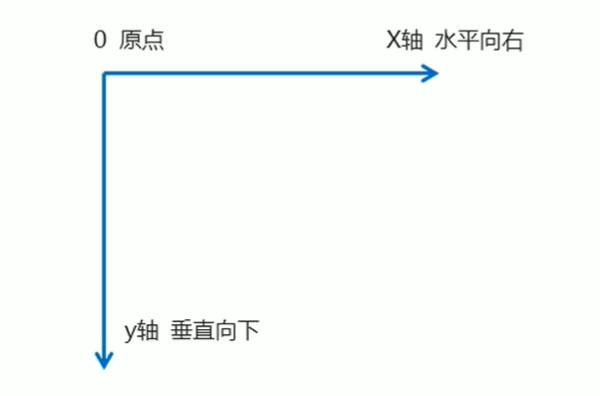# 变化
# 2D平移 translate
# 二维坐标系
2D转换是改变标签在二维平面上的位置和形状的一种技术,先来学习二维坐标系

2D移动是2D转换里面的一种功能,可以改变元素在页面中的位置,类以定位
- 定义2D转换中的移动,沿着X和Y轴移动元素
- translate:最大的优点:不会影响到其他元素的位置
- translate中的百分比单位是相对于自身元素的translate:(50%,50%):
- 对行内标签没有效果
- 如果使用百分号,移动的距离是盒子自身高度或者高度来对比的
- 对行内标签没有效果
<body>
<div></div>
</body>
<style>
div {
width: 100px;
height: 100px;
background-color: red;
/*
x就是x轴上移动位置y就是y轴上移动位置中间用逗号分隔
transform:translate(x,y);
*/
/*transform: translate(100px, 0);*/
/*transform: translate(100px, 100px);*/
transform: translateX(100px);
}
</style>
# 垂直剧中
<body>
<div>
<p></p>
</div>
</body>
<style>
div {
width: 500px;
height: 500px;
background-color: red;
position: relative;
}
p {
position: absolute;
top: 50%;
left: 50%;
width: 100px;
height: 100px;
background-color: blue;
transform: translate(-50%, -50%);
}
</style>
# 2D旋转 rotate
2D旋转指的是让元素在2维平面内顺时针旋转或者逆时针旋转。
transform:rotate(度数)
- rotate里面跟度数,单位是deg比如rotate(45deg)
- 角度为正时,顺时针,负时,为逆时针
- 默认旋转的中心点是元素的中心点
<body>
<img src="../static/img/account.png">
</body>
<style>
img {
transform: rotate(50deg);
}
</style>
# 2D缩放 scale
缩放,顾名思义,可以放大和缩小。只要给元素添加上了这个属性就能控制它放大还是缩小。
transform:scale(x,y);
- 注意其中的x和y用逗号分隔
- transform:scale(1,1):宽和高都放大一倍,相对于没有放大
- transform:scale(2,2):宽和高都放大了2倍
- transform:scale(2):只写一个参数,第二个参数则和第一个参数一样,相当于scale(2,2)
- transform:scale(0.5,0.5):缩小
- scale缩放最大的优势:可以设置转换中心点缩放,默认以中心点缩放的,而且不影响其他盒子
<body>
<div></div>
</body>
<style>
div {
width: 200px;
height: 200px;
background-color: skyblue;
}
div:hover {
transform: scale(1.1,1);
}
</style>
# 2D倾斜 skew
语法:transform: skew(x,y);
div {
transform: skew(20deg, 30deg);
}
<!DOCTYPE html>
<html lang="en">
<head>
<meta charset="UTF-8">
<title>Title</title>
<style>
.box {
width: 200px;
height: 200px;
position: absolute;
left: 50%;
top: 50%;
background-color: skyblue;
/*
倾斜效果
正的是往左倾斜,负的是往右
*/
transform: translateX(-50%) translateY(-50%) skew(20deg);
}
</style>
</head>
<body>
<div class="box"></div>
</body>
</html>
# 2D中心点 transform-origin
transform-origin:x y;
- 注意后面的参数X和y用空格隔开
- × y默认转换的中心点是元素的中心点(50%50%)
- 还可以给xy设置像素或者方位名词(top bottom left right center)
<body>
<div></div>
</body>
<style>
div {
width: 200px;
height: 200px;
background-color: skyblue;
margin: 200px auto;
transition: all 1s;
/**
transform-origin: left bottom;
默认是center center
*/
transform-origin: 50px 20px;
}
div:hover {
transform: rotate(360deg);
}
</style>
# 2D综合写法
- 同时使用多个转换,其格式为:transform: translate() rotate() scale() 等
注意
这里的执行顺序是 先执行最右侧的,从右往左
# 过度 transition
过渡(transition)是CSS3中具有颠覆性的特征之一,我们可以在不使用Flash动画或JavaScript的情况下,当元素从一种样式变换为另一种样式时为元素添加效果。 过渡动画:是从一个状态渐渐的过渡到另外一个状态
可以让我们页面更好看,更动感十足,虽然低版本浏览器不支持(i9以下版本)但是不会影响页面布局。
现在经常和:hover一起搭使用。
语法:
transition:要过渡的属性 花费时间 运动曲线 何时开始;
- 属性:想要变化的css属性,宽度高度背景颜色内外边距都可以。如果想要所有的属性都变化过渡,写一个a‖就可以。
- 花费时间:单位是秒(必须写单位)比如0.5s
- 运动曲线:默认是 ease(可以省略)
- 何时开始:单位是秒(必须写单位)可以设置延迟触发时间默认是0s(可以省略)
# 运动曲线
| 值 | 说明 | 效果特点 |
|---|---|---|
linear | 匀速 | 从头到尾保持相同速度 |
ease | 默认值 | 开始慢 → 中间快 → 结束慢 |
ease-in | 先慢后快 | 动画逐渐加速 |
ease-out | 先快后慢 | 动画逐渐减速 |
ease-in-out | 先慢→中间快→再慢 | 两头慢,中间快 |
cubic-bezier(x1, y1, x2, y2) | 自定义贝塞尔曲线 | 通过控制点控制速度曲线 |
steps(n, start/end) | 分步动画 | 将过渡分为 n 步骤执行,可模拟逐帧效果 |
多个之间用逗号,所有的属性用all
<body>
<div class="parent">
</div>
</body>
<style>
.parent {
width: 200px;
height: 200px;
background-color: skyblue;
}
.parent:hover {
width: 400px;
height: 400px;
transition: width 0.5s ease ;
}
</style>
多个
<body>
<div class="parent">
</div>
</body>
<style>
.parent {
width: 200px;
height: 200px;
background-color: skyblue;
}
.parent:hover {
width: 400px;
height: 400px;
transition: all 0.5s ease, height 0.5s ease;
}
</style>
# 3D转换
# 三维坐标系
三维坐标系其实就是指立体空间,立体空间是由3个轴共同组成的。
- x轴:水平向右 注意:X右边是正值,左边是负值
- y轴:垂直向下 注意:y下面是正值,上面是负值
- Z轴:垂直屏幕 注意:往外面是正值,往里面是负值
注意
3D效果需要在父容器上设置 preserve-3d
div {
transform-style: preserve-3d;
}
# 3D 转换 透视 perspective
在2D平面产生近大远小视觉立体,但是只是效果二维的,如果想要在网页产生3D效果需要透视(理解成3D物体投影在2D平面内)。模拟人类的视觉位置,可认为安排一只眼睛去看
- 透视我们也称为视距:视距就是人的眼睛到屏幕的距离
- 距离视觉点越近的在电脑平面成像越大,越远成像越小透视的单位是像素
- 数值越小,透视效果越强
- 父元素添加,所有子元素都会添加透视效果
- 子元素添加,当前元素拥有透视效果
注意
perspective()必须作为transform属性的第一个函数(否则无效)
<body>
<div></div>
</body>
<style>
body {
/*透视写在被观察元素的父盒子上面*/
perspective: 100px;
}
div {
width: 200px;
height: 200px;
background-color: skyblue;
transform: translateX(100px) translateY(100px) translateZ(0);
}
</style>
# 3D移动 translate3d
3D移动在2D移动的基础上多加了一个可以移动的方向,就是轴方向。
- translform:translateX(10Opx):仅仅是在x轴上移动
- translform:translateY(100px):仅仅是在Y轴上移动
- translform:translateZ(10Opx):仅仅是在Z轴上移动(注意:translateZ一般用px单位)
- transform:translate3d(xy,z):其中X、y、Z分别指要移动的轴的方向的距离
<body>
<div></div>
</body>
<style>
div {
width: 200px;
height: 200px;
background-color: skyblue;
transform: translateX(100px) translateY(100px) translateZ(100px);
/*
trans1ateZ行着Z轴移
translateZ后面的单位我们一般跟px
translateZ(1gpx)向外移动1o8px(向我们的眼睛来移动的)
3D移动有简写的方法
transform: translate3d(100px,100px,100px);
xyz是不能省略的,如果没有就写0
transform: translate3d(0,100px,100px);
*/
}
</style>
# 3D 卡片反转效果
<!DOCTYPE html>
<html lang="en">
<head>
<meta charset="UTF-8">
<title>Title</title>
<style>
.parent {
perspective: 1000px;
position: relative;
}
.parent > div {
transition: all .7s;
position: absolute;
top: 0;
left: 0;
/*当转到后面的时候隐藏*/
backface-visibility: hidden;
}
.front {
width: 500px;
height: 500px;
background-color: skyblue;
color: white;
line-height: 500px;
text-align: center;
z-index: 1;
}
.parent:hover .front {
transform: rotateY(-180deg);
}
.parent:hover .backend {
transform: rotateY(0);
}
.backend {
width: 500px;
height: 500px;
background-color: orange;
color: white;
text-align: center;
line-height: 500px;
transform: rotateY(180deg);
}
</style>
</head>
<body>
<div class="parent">
<div class="front">正面</div>
<div class="backend">反面</div>
</div>
</body>
</html>
# 动画
动画(animation)是CSS3中具有颠覆性的特征之一,可通过设置多个节点来精确控制一个或一组动画,常用来实现复杂的动画效果。
相比较过渡,动画可以实现更多变化,更多控制,连续自动播放等效果
语法:animation:动画名称 动画时长 速度曲线 延迟时间 播放次数 播放方向 执行完毕状态
- 动画名称和动画时长是必写,其余可以省略,但是要保证书写顺序 动画属性要写到目标元素里面
- 播放次数: 需要无限循环写 infinite
- 播放方向: reverse(反向),alternate(交替)
- 执行完毕状态:动画结束后状态(如forwards保留最后一顿,backwards回到第一帧)
# 常用属性
| 属性 | 描述 |
|---|---|
| @keyframes | 规定动画。 |
| animation | 所有动画属性的简写属性,除了animation-play~state)属性。 |
| animation-name | 规定@keyframes2动画的名称。(必须的) |
| animation-duration | 规定动画完成一个周期所花费的秒或毫秒,默认是0。(必须的) |
| animation-timing-function | 规定动画的速度曲线,默认是“ease” |
| animation-delay | 规定动画何时开始,默认是0。 |
| animation-iteration-count | 规定动画被播放的次数,默认是1,还有infinite |
| animation-direction | 规定动画是否在下一周期逆向播放,默认是"normal“,alternate逆播放 |
| animation-play-state | 规定动画是否正在运行或暂停。默认是"running",还有"pause"。 |
| animation-fill-mode | 规定动画结束后状态,保持orwards回到起始backwards |
# 动画的基本使用
制作动画分为两步:
- 先定义动画
- 再使用(调用)动画
<body>
<div></div>
</body>
<style>
div {
width: 200px;
height: 200px;
background-color: skyblue;
/*调用动画*/
animation-name: move;
/*持续时间*/
animation-duration: 1s;
/*也可以简写*/
animation: move 1s;
}
/*定义状态*/
@keyframes move {
/*开始状态*/
0% {
transform: translateX(0px);
}
/*结束状态*/
100% {
transform: translateX(1000px);
}
}
</style>
# 逐帧动画 steps
steps是CSS动画中用于控制动画分段执行的计时函数,类似于小时候在课本上每张纸上画一个人物,然后快速的滚动效果
语法:animation: 动画名称 动画持续时间 速度曲线steps(步数) 连续播放;
<style>
@keyframes move {
from {
width: 100px;
}
to {
width: 200px;
}
}
div {
animation: move 1s steps(2);
}
</style>
# 滚动时间线 animation-timeline
animation-timeline是CSS中用于控制动画时间线的核心属性,它允许开发者将动画进度与特定事件(如滚动、视口可见性)绑定,从而实现更复杂的交互效果。
兼容注意
animation-timeline目前很多都不支持。
<!DOCTYPE html>
<html lang="en">
<head>
<meta charset="UTF-8">
<title>动画时间线</title>
<style>
@keyframes scrollBar {
0% {
width: 0;
}
100% {
width: 100%;
}
}
.nav-bar {
width: 100%;
height: 50px;
background-color: #FFF;
position: fixed;
top: 0;
}
.scroll-bar {
width: 100%;
background-color: red;
height: 2px;
/*使用定义的滚动动画*/
animation: scrollBar 1s;
/*滚动时间线*/
animation-timeline: scroll();
}
</style>
</head>
<body>
<div class="nav-bar">
<!--滚动条-->
<div class="scroll-bar"></div>
</div>
<div id="content"></div>
<script>
const content = document.getElementById("content");
for (let i = 0; i < 500; i++) {
const div = document.createElement("div");
div.textContent = "我是子节点";
content.appendChild(div);
}
</script>
</body>
</html>
# 视图时间线
视图时间线:动画进度与元素进入/离开视口的可见性关联(也就是当页面进入到某个可见范围的时候触发)
<!DOCTYPE html>
<html lang="en">
<head>
<meta charset="UTF-8">
<title>视口时间线</title>
<style>
header,
bottom {
height: 2000px;
}
/*动画,图像放大*/
@keyframes scale {
0% {
transform: scale(1.1);
opacity: 0.5;
font-size: 20px;
}
100% {
transform: scale(1.5);
opacity: 1;
font-size: 30px;
}
}
section {
text-align: center;
display: flex;
justify-content: space-between;
align-items: center;
}
section img {
animation: scale 1s;
/*绑定视图时间线*/
animation-timeline: view();
}
section span {
animation: scale 1s;
/*绑定视图时间线*/
animation-timeline: view();
}
</style>
</head>
<body>
<header>顶部</header>
<section>
<div>
<img src="https://picsum.photos/200" alt="demo">
</div>
<div>
<span>当页面可以见到我之后触发</span>
</div>
<div>
<img src="https://picsum.photos/200" alt="demo">
</div>
</section>
<bottom>底部</bottom>
</body>
</html>